Search the Special Collections and Archives Portal
Search Results
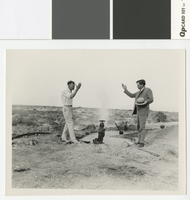
Photograph of Fred Hesse and Fred Balzar opening an artesian well in Las Vegas, circa 1930
Date
Archival Collection
Description
Las Vegas mayor J. Fred Hesse (left) and Nevada governor Fred Balzar (right) at opening of an artesian well in Las Vegas
Transcribed Notes: Notes on photo sleeve: "Las Vegas Mayor J. Fred Hesse (left) and Nev. Governor Fred Balzar at opening of an artesian well in Las Vegas, ca. 1929-32"; Stamped on back of photo: G. L. Ullom. 104 Fremont Street. Las Vegas, Nevada
Image
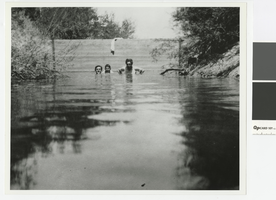
Photograph of Floyd Francis and Jake Beckley in the swimming hole on the Von Tobel and Beckley property, circa 1910
Date
Archival Collection
Description
Floyd Francis (center), Jake Beckley (right), and unidentified man in the "Old Swimming Hole" on the Von Tobel and Beckley property
Transcribed Notes: Transcribed from photo sleeve: "Floyd Francis (center), Jake Beckley (right), and unidentified man (on left) in an old swimming hole formed on the property of Von Tobel and Beckley."; Transcribed background history: "Early Las Vegas History by Florence Lee Jones, April 1969: Creating their own oasis in the Las Vegas Valley was the hobby of the late Ed Von Tobel, Sr., and his partner, the late Jake Beckley, when they came to Las Vegas in 1905 as gay young bachelors. At their ranch in Paradise Valley, where they owned the 120 acres now comprising the Sierra Vista Ranchos, exclusive residential area, they used the facilities at hand to form an 'old swimming hole.' From one of the three wells they drilled they diverted the free-flowing water into a nearby creek bed, built a cement dam to contain the water, and had their own pleasure resort. In this picture, from left, an unidentified man; Floyd Francis, early employee of the Von Tobel Lumber Company; and Jake Beckley, a partner in the fi
Image
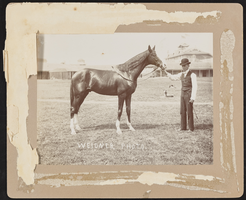
Photograph of a horse belonging to Evelyn Stewart
Date
Archival Collection
Description
Image

Photograph of highway ribbon cutting at Mount Rose, Reno (Nev.), 1950s
Date
Archival Collection
Description
Image
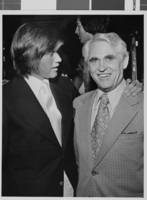
Photograph of Wayne Newton with Mayor Oran K. Gragson, circa 1960s
Date
Archival Collection
Description
Image
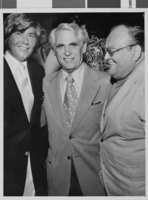
Photograph of Wayne Newton with Mayor Oran K. Gragson, circa 1960s
Date
Archival Collection
Description
Image
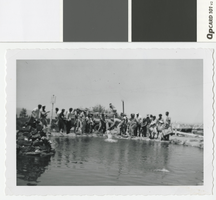
Photograph of a group of men releasing live rainbow trout into a pond, late 1950s
Date
Archival Collection
Description
Rainbow trout being released into a pond
Transcribed Notes: Transcribed from back of photo: "Dad & [Harold] unloading trout"
Image
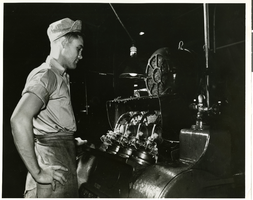
Photograph of a man working on rock bit drilling pieces at the Hughes Tool Co., Houston, Texas, circa 1950s
Date
Archival Collection
Description
Image
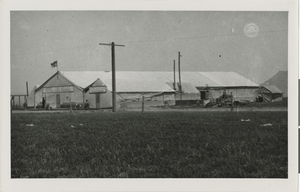
Photograph of the Hotel Las Vegas (Las Vegas), 1905
Date
Archival Collection
Description
The Hotel Las Vegas was the first hotel in Las Vegas, a tent set up for people who came to participate in the land auction. Managed by Pop Squires." Transcribed from back of photo: "Hotel Las Vegas 1905. Hotel Las Vegas, built by Las Vegas Trading Co. in 1905 was located on North Main Street between Stewart and the creek across from Woodards Down Town Camp on grounds later occupied by Elwells Ware House. All canvas and lumber used in building was cut to size and holes bored in Los Angeles, ready to be bolted together on arrival in Las Vegas. Hotel had 20 rooms. Floor space was 40 x 130 ft. Kitchen and Dining Room are seen next door to Hotel on the right. This Hotel was managed by Chas. P. Squires. Photo by Eddie Gillette, 1905." Transcribed from Special Collections sheet: "Selling of L.V. First L.V. Hotel pic cap. First Las Vegas Hotel -- The Hotel Las Vegas was made ready for the first buyers of real estate at the 1905 auction when the Las Vegas Trading Co., managed by Charles (Pop) Squires, opened the registry. All canvas and lumber used in building was cut to size and holes bored in Los Angeles, a prefab forerunner. Hotel Las Vegas boasted 20 rooms and was regarded as the top 'night spot' of its day."
Site Name: Hotel Las Vegas
Address: 1 Fremont Street
Image
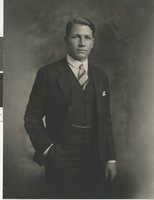
Photograph of Leonard Fayle, (Nev.), late 1920s
Date
Archival Collection
Description
Image
